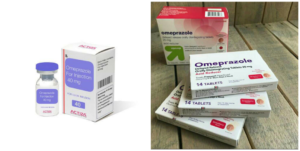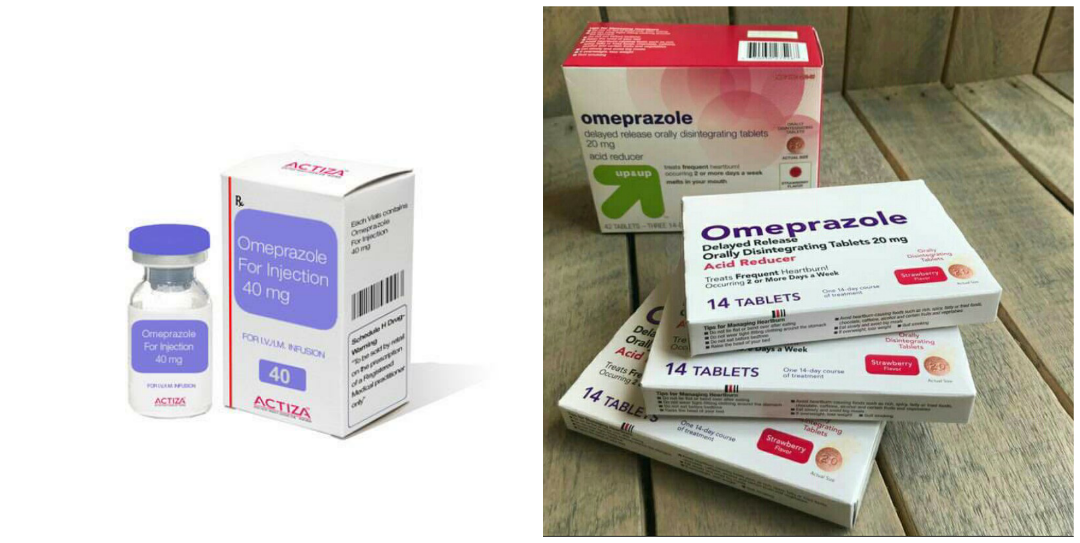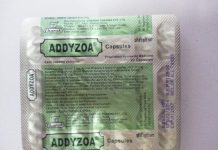Omeprazole: Composition, Uses, Indications, Contraindications, Interactions, Dosage, Side Effects and Price.
Omeprazole Sodium 40mg/vial – A Proton Pump Inhibitor .
The reconstituted solution is for single use only.
COMPOSITION:
Each vial of Omeprazole injection powder for reconstitution for injection contains omeprazole sodium 4.26mg, equivalent to omeprazole 4mg.

PHARMACOLOGICAL ACTIONS:
Classified as Gastric acid secretion inhibitor. Omeprazole injection is an alternative to oral therapy.
Pharmacodynamics:
Omeprazole is a specific inhibitor of the gastric proton pump in the parietal cell and thus reduces the secretion of gastric acid. Reversible control of gastric acid secretion is produced with single daily doses of omeprazole.
The apparent volume of distribution in healthy subjects is approximately 0.31/kg body weight Omeprazole is 97% plasma protein bound.
Pharmacokintetics:
Omeprazole is completely metabolized by the cytochrome P450 system (CYP). The major part of its metabolism is dependent on the polymorphically expressed CYP2C19, responsible for the formation of hydroxyomeprazole, the major metabolite in plasma.
The remaining part is dependent on another specific isoform, CYP3A4, responsible for the formation of omeprazole sulfone. As a consequence of high affinity of omeprazole to CYP2C19, there is a potential for competitive inhibition and metabolite drug-drug interactions with other substrates for CYP2C19.
However, due to low affinity to CYP3A4, omeprazole has no potential to inhibit the metabolism of other CYP3A4 substrates. In addition, omeprazole lacks an inhibitory effect on the main CYP enzymes. Approximately 3% of the Caucasian population and 15.20% of Asian populations lack a functional CYP2C19 enzymes.
Approximately 3% of the Caucasian population and 15.20% of Asian populations lack a functional CYP2C19 enzyme and are called poor metabolisers. In such individuals the metabolism of omeprazole is probably mainly catalysed by CYP3A4.
After repeated one-daily administrations of 20mg omeprazole, the mean AUC was 5 to 10 times higher in poor metabolisers than in subjects having a functional CYP2C19 enzyme (extensive metabolisers). Mean peak plasma concentrations were also higher, by 3 to 5 times. These findings have no implications for the posology of omeprazole.
Elimination:
Total plasma clearance is about 30-40minutes – 1hour after a single doses the plasma elimination half-life of omeprazole is usually shorter than one hour both after single and repeated one-daily dosing. It is completely eliminated from plasma between doses. Almost 80% of a dose of omeprazole is excreted as metabolits in the urine, the remainder in the faeces, primarily originating from bile secretion.
Linearity/non-linearity:
The AUC of omeprazole increases with repeated administration due to a decrease of systemic clearance probably caused by an inhibition of the CYP2C19 enzyme by omeprazole and/or its metabolites (e.g the sulfone). No metabolite has been found to have any effect on gastric acid secretion.
Special populations:
Hepatic impairment: The metabolism of omeprazole in patients with liver dysfunction is impaired, resulting in an increased AUC. It has not shown any tendency to accumulate with once-daily dosing.
Renal impairment: The pharmokinetics of omepra-zole, including systematic bioavailability and elimination rate, are unchanged in patients with reduced renal function.
Older people: The metabolism rate of omeprazole is somewhat reduced in elderly subjects (75.79 years of age)
USES OR INDICATIONS OF OMEPRAZOLE:
Omeprazole injection is indicated as an alternative to oral therapy for the following indications:
💠Treatment of duodenal ulcers;
💠Prevention of relapse of duodenal ulcers;
💠Treatment of gastric ulcer;
💠Prevention of relapse of gastric ulcers; in combination with appropriate antibiotics;
💠Helicobacter pylori (H pylori) eradication in peptic ulcer disease;
💠Treatment of NSAID-associated gastric and duodenal ulcers;
💠Prevention of NSAID-associated gastric and duodenal ulcers in patients at risk;
💠Treatment of reflux esophagitis;
💠Long-term management of patients with healed reflux esophagitis;
💠Treatment of Symptomatic gastro-esophageal reflux disease;
🔷Treatment of Zollinger-Ellison syndrome.
RECONSTITUTION:
One vial with omeprazole injection powder should be mixed with one ampoule containing 10ml of the solvent for solution for injection. A clear solution should be obtained. With a syringe draw all of the sterile water for injection (WFI) from the ampoule (10ml). Add approximately 5ml of the sterile water for injection to the vial with freeze-dried omeprazole. Withdraw as much air as possible from the vial back into the syringe. This will make it easier to add the remaining solvent. Add the remaining solvent into the vial, make sure the syringe is empty. Rotate and shake the vial to ensure all the freeze-dried omeprazole has dissolved.
Important Intravenous (I.V.) note
Omeprazole injection powder must be given only as an intravenous injection and it must not be added to infusion solutions.
After reconstitution the injection should be given s lowly over a period of at least 2.5 minutes at a maximum rate of 4ml per minute. Any unused product or waste material should be disposed of in accordance with local requirements.
DOSAGE:
(Adult) In patients where the use of oral medicinal products is inappropriate.
Omeprazole Injection I.V. 40mg once daily is recommend.
In patients with Zollinger-Ellison Syndrome the recommended initial dose of Omeprazole given intravenously is 60mg daily. Higher daily doses may be required and the dose should be adjusted individually.
When dose exceed 60mg daily, the dose should be divided and given twice daily
Paediatrics: The safety and efficacy of Omeprazole in Children has not been established.
Elderly: No dose adjustment is required in the elderly.
Impaired Renal Function: No dose adjustment is required in patients with reduced renal function
Impaired Hepatic Function: Due to an increase in the bioavailability plasma half-life of omeprazole in patients with impaired hepatic function a daily dose of 40mg is generally adequate.
The long-term safety of proton pump inhibitor in patients with renal and hepatic impairment has not been established.
SIDE-EFFECTS OF OMEPRAZOLE
The most commonly reported side-effects are: Nausea/vomiting, headache, diarrhoea, constipation, abdominal pain and flatulence, rash and/or pruritis, dizziness, paraesthesia, somnolence, insomnia, vertigo, increased liver enzymes and malaise.
The following have occurred in a few cases:
Photosensitivity, erythema multiforme, alopecia; arthralgia, muscular weakness, myalgia, reversible mental confusion, agitation, depression and hallucinations, mostly in severely ill patients.
Dry mouth, stomatitis and gastrointestinal candidiasis.
Hepatic Encephalopathy in patients with pre-existing severe liver disease; hepatits with or without jaundice, hepatic failure, increases in liver enzymes have been observed.
Gynaecomastia, Leukopenia and thrombocytopenia, Hypersensitivity reactions e.g urticaria, angiodema, fever, bronchospasm and interstitial nephritis, Increased sweating, peripheral oedema, blurred vision and taste disturbance.
During long-term treatment gastric glandular cysts have been reported to occur more frequently. These changes are benign and seem to be reversible and are a physiological consequences of pronounced inhibition of acid secretion.
If a gastric ulcer, is suspected, the possibility of malignancy should be excluded as treatment may mask the symptoms and delay diagnosis.
SPECIAL PRECAUTIONS
Omeprazole may hide the symptoms of other disease. Therefore, if any of the following exists/or observed before/after been given Omeprazole. Lose a lot of weight for no reason, problems swallowing, stomach pain or indigestion, vomit food or blood, black stools (blood-stained faeces), severe or persistent diarrhoea (it has been associated with a small increase in infections diarrhoea), severe liver problems.
In the presence of any alarm symptoms (e.g significant unintentional weight loss, recurrent vomiting, dysphagia, haematemesis or melena) and when gastric ulcer is suspected or present, malignancy should be excluded, as treatment may alleviate symptoms and delay diagnosis.
Co-administration of atazanavir with proton pump inhibitors is not recommended. If the combination of atazanavir with a proton pump inhibitor is judged unavoidable, close clinical monitoring (e.g. virus load) is recommended in combination with an increase in the dose of atazanavir to 400mg with 100mg of ritonavir, omeprazole 20mg should not be exceeded.
Omeprazole as all acid-blocking medicines, may reduce the absorption of vitamin B12 (cyanocobalamin) due to hypo- or achlorhydria.
This should be considered in patients with reduced body stores or risk factors for reduced vitamin B12 absorption of long-term therapy.
Omeprazole is a CYP2C19 inhibitor.
When starting or ending treatment with omeprazole, the potential for interactions with drugs metabolized through CYP2C19 should be considered. An a precaution, concomitant use of omeprazole and clopidogerl should be discouraged.
Treatment with proton pump inhibitors may lead to slightly increased risk of gastrointestinal infections such as salmonella and campylobacter.
Severe hypomagnesemia has been reported in patients treated with proton pump inhibitors like omeprazole for at least three months, and in most cases for a year. Serious manifestations of hypomagnesemia such as fatigue, tetany, delirium, convulsions, dizziness and ventricular arrhythmia can occur but they may begin insidiously and be overlooked. In most affected patients, hypomagnesemia improved after magnesium replacement and discontinuation of the proton pump inhibitor.
For patients expected to be on prolonged treatment or who take proton pump inhibitors with digoxin or drugs that may cause hypomagnesemia (e.g. diuretics), health care professionals should consider measuring magnesium levels before starting proton pump inhibitor treatment and periodically during treatement.
Proton pump inhibitor especially if used in high dose and over long duration (<1 year), may modestly increase the risk of hip, wrist and spine fracture, predominantly in the elderly or in presence of other recognized risk factors. Observational studies suggest that proton pump inhibitors may increase the overall risk of fracture by 10-40%. Some of this increase may be due to other risk factors.
Patient at risks of osteroporosis should receive care according to current clinical guidelines and they should have an adequate intake of vitamin D and calcium. As in all long-term treatments, especially when exceeding a treatment period of 1 year, patients should be kept under regular surveillance.
Pregnancy: Results from three prospective epidemiological studies (more than 1000 exposed outcomes) indicate no adverse effects of omeprazole on pregnancy or on the health of the foetus/newborn child. Omeprazole can be sued during pregnancy.
Breastfeeding: Omeprazole is excreted in breast milk but is not likely to influence the child when therapeutic doses are used.
Fertility: Animal studies with the racemic mixture omeprazole, do not indicate effects with respect to fertility.
INTERACTIONS
Omeprazole can prolong the elimination of medicines which are metabolized by oxidation in the liver, e.g. warfarin, diazepam and phenytoin. Patients receiving warfarin or phenytoin concomitant with omeprazole, should be monitored closely as a reduction in dosages of warfarin or phenytoin may be required.
It was however shown in patients on concurrent omeprazole treatment at a daily dosage of 40mg and continous phenytoin treatment, that the simultaneous use of these two medications did not influence the blood concentration of phenytoin. Concomitant treatment with omeprazole 40mg daily also did not alter coagulation time in patients on long-term treatment.
There is a possibility of interactions with medicines metabolized via the cytochrome P450 enzyme system, although no interactions with propranolol, metroprolol, theophylline, lignocaine, quinidine and amoxicillin have been recorded.
No interaction with food or the concurrent administration of antacid medications has been found. The plasma concentrations of both omeprazole and clarithromycin may be increased during concomitant treatment with these medicines.
An increase of approximately 10% in the bioavailability of digoxin were recorded in healthy volunteers due to the increase in intra-gastric pH when omeprazole and digoxin are administered concurrently.
OVERDOSE AND TREATMENT
There is limited information available on the effects of overdoses of omeprazole in humans. In the literature, dose of up to 560mg have been described, and occasional reports have been received when single oral does have reached up to 2,400mg omeprazole (120 times the usual recommended clinical dose) Nausea, vomiting, dizziness, abdominal pain, diarrhoea and headache have been reported.
Also apathy, depression and confusion have been described in single cases. The symptoms described have been transient, and no serious outcome has been reported. The rate of elimination was unchanged (first order kinetics) with increased doses.
Intravenous doses of up to 270mg on a single day and up to 650mg over a three-day period have been given in clinical trials without any does-related adverse reactions. Treatment is symptomatic and supportive.
PRESENTATION:
One 10ml colourless glass vial containing Omeprazole powder in a transparent plastic blister with 10ml colourless glass ampoule sterile water for injection per pack (1 x 40mg)
STORAGE:
Store below 20oC, Protect from light. Do not use Omeprazole injection 40mg powder for constitution after the expiry date which is state on the label after expiration. After preparation of the solution.
It must be stored and used within four hours. The reconstituted solution should not be used if particles are present.
Shelf-life of Omeprazole: 2 years
PRICE
The cost of omperazole is around #500 Naira per vial in Nigeria and about $2 in the US and UK.
KEEP OUT OF REACH OF CHILDREN
























